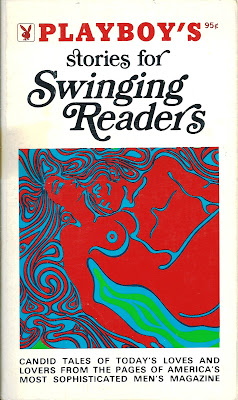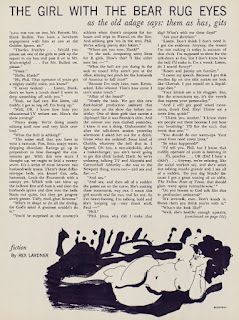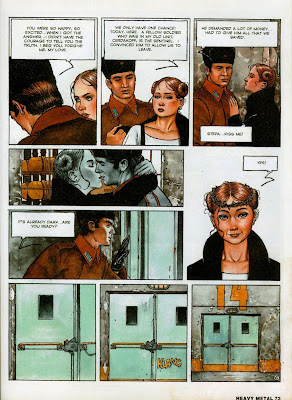Thursday, February 17, 2022
Book Review: The School on 103rd Street
Monday, February 14, 2022
Book Review: Playboy's Stories for Swinging Readers
Friday, February 11, 2022
Killerbowl now is PoD
Thursday, February 10, 2022
More Devil's Kisses, Corgi Books, the National Lampoon, and Scotland Yard
[ The glasses also will come in handy if you happen to own a copy of 'The Illustrated Harlan Ellison' (1978). ]
Tuesday, February 8, 2022
Book Review: Be Pure ! Be Vigilant ! Behave !
2000 AD and Judge Dredd: The Secret History
‘Be Pure ! Be Vigilant ! Behave ! 2000 AD and Judge Dredd: A Secret History (255 pp.) was published by Millsverse Books in 2017.
Pat Mills (b. 1949) is of course one of the most well-known representatives of the comic book business in the UK and one of its more iconoclastic figures. As the above quotation shows, excessive modesty and humility are not in particularly abundant supply in the pages of ‘Be Pure !’, which chronicles Mills’s career in comics from the early 1970s up to 2017, the 40th anniversary of the first issue of 2000 AD.
The book consists of brief chapters, arranged in a loose chronological order. Things start in 1971, when Mills and fellow talent John Wagner were living and working in Scotland for D. C. Thompson and its lineup of romance and humor titles. The narrative then moves to London, where Mills was involved with Battle Picture Weekly and Action before being asked by IPC in 1976 to launch a science-fiction title, one capable of exploiting the anticipated boom in the genre associated with the release of an American film called Star Wars.
Mills rightly devotes considerable space to his work developing 2000 AD and his collaborations with other artists and writers to create the memorable characters that made the comic so successful when it launched in February 1977. These are the book's most interesting chapters.
Subsequent chapters describe Mills’s freelance career writing for additional 2000 AD comics, such as Crisis, for which he created ‘Third World War’. Mills also offers vignettes about working for American publishers Marvel and DC; his involvement with the indie comic Toxic in the early 1990s; and his partnership with the French artist Olivier Ledroit on the title 'Requiem: Vampire Knight'.
Throughout ‘Be Pure !’ Mills, as one might expect, freely expresses his opinions about the comic book industry in the UK and its faults (which, as Mills sees them, are myriad). Mills regards anyone who interfered with his creative vision as a cretin, and thus, former 2000 AD editors Steve McManus, Alan MacKenzie, John Tomlinson, and David Bishop (among many others) all are the targets of his animadversions.
Mills’s ongoing antipathy (which has reached pathological levels, in my opinion) for the De La Salle Order and its former faculty at his grammar school, St. Joseph’s College in Ipswich, also comes in for treatment in the pages of ‘Be Pure !’. It seems that the De La Salle Order members Brother James and Brother Solomon, as Mills refers to them, were the inspirations both for Dredd, and 'Torquemada' from 'Nemesis the Warlock'.
Saturday, February 5, 2022
The Marriage of Irina Valienko
Thursday, February 3, 2022
Tuesday, February 1, 2022
Jim Osborne: The Black Prince of the Underground
The Black Prince of the Underground
Jim Osborne was born in Monroe, Louisiana, in 1943 and grew up in Texas. After a stint in the U.S. Army from 1963 – 1966, he moved to San Francisco in 1968, where he embraced the counterculture and began to submit comics to the local underground newspapers. He soon became a well-known figure in the city’s burgeoning comix scene.
By the late 70s Osborne began to lose interest in contributing to comix, and his problems with substance abuse were only made worse by the death of his brother Dan from a drug overdose in 1991. Osborne did only a few art pieces during the 1990s, and died in 2001 due to chronic alcoholism.‘Jim Osborne: The Black Prince of the Underground’ compiles all of Osborne’s comix and graphic art (these all were done in black-and-white). It also includes a biographical sketch of Osborne, with anecdotes and reminiscences from family and friends and other comix artists. And it’s physically smaller than the usual dimensions of the comics-related books published by Fantagraphics (such as multi-volume set of books dealing with 'Spain' Rodriguez), but it had the same high production values one would expect from Fantagraphics.
It should be emphasized that Osborne was second to none – including S. Clay Wilson – when it came to using comix as a vehicle to depict all manner of explicit, disturbing horrors and depravities, so I’m not sure who, exactly, will be interested in picking up the book. I had to search very carefully for excerpts from the book that I could scan to use in this review.
Perverts, murderers, demons, and drug addicts all populate the comix and art of Jim Osborne, where their iniquities often are accompanied by notes of black humor.
Aside from the dwindling cohort of people that remember Osborne’s comics from the 60s and 70s, I’m guessing that the Gorehounds who devour modern-day, full- color comics from Avatar like Crossed and Uber, likely will find delight in Osborne’s gruesome portrayals of libertines, cannibals, serial killers, demons, and other degenerates.
One thing that really comes across well in the pages of ‘Jim Osborne’ is the intricate nature of his artwork, which originally was printed on newsprint-grade paper by obsolete presses manned by comix publishers in condemned warehouses in San Francisco.
Unfortunately, 'Jim Osborne' is now out of print, and finding a copy for sale for a price anywhere close to its cover price of $25 is difficult, if not impossible. I don't know if Fantagraphics decided on a limited print run for the book because they thought it was a niche item, or because they were nervous about obscenity charges, but until they decide to launch another printing, or issue an eBook, 'Jim Osborne' is among the rarest of the rare. If you see a copy for an affordable price, grab it !






















































.jpg)

















